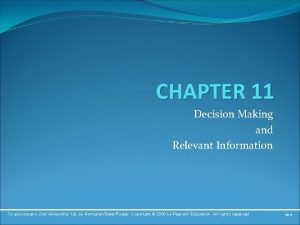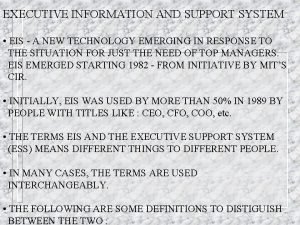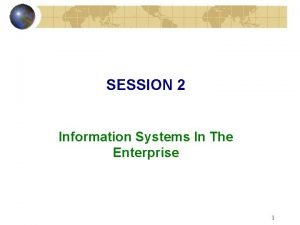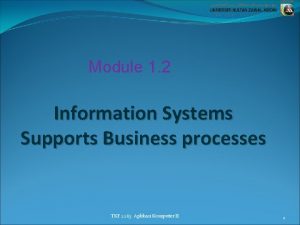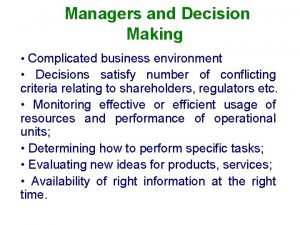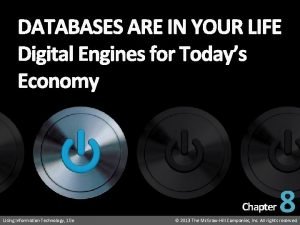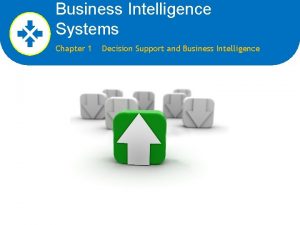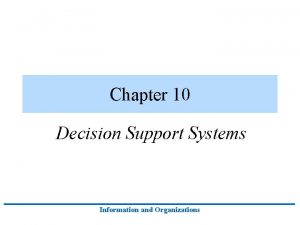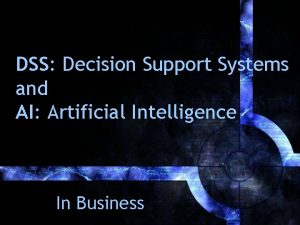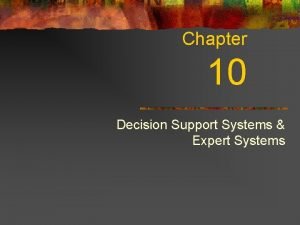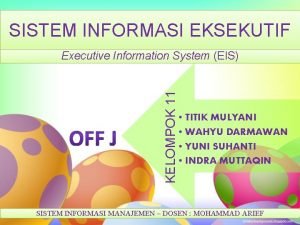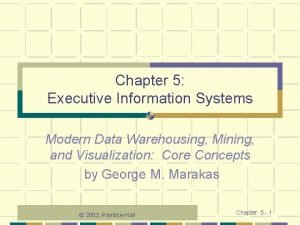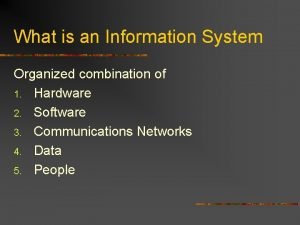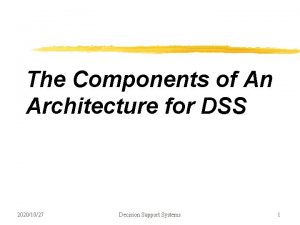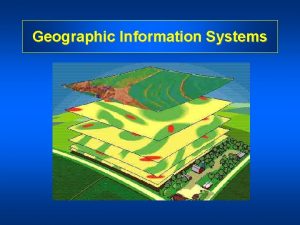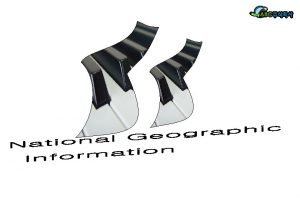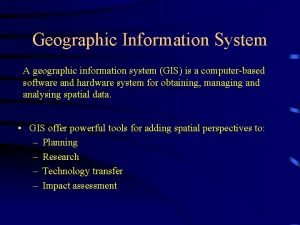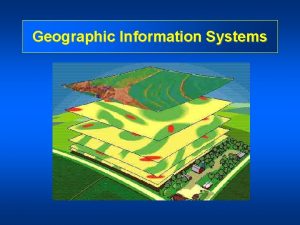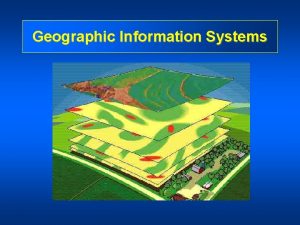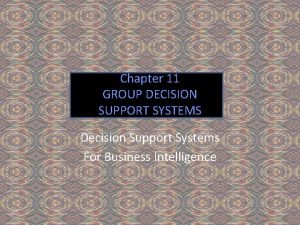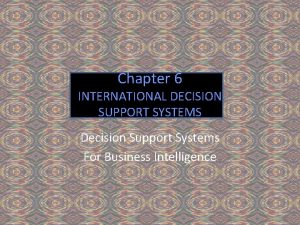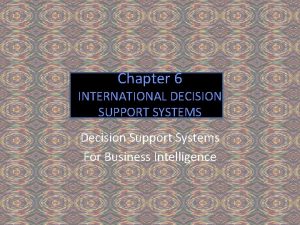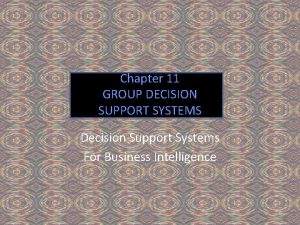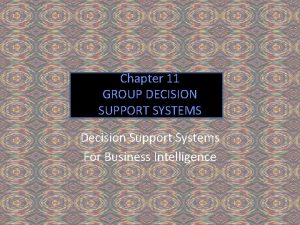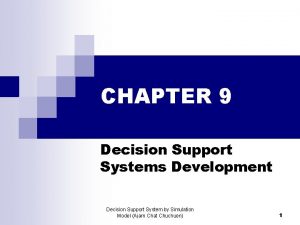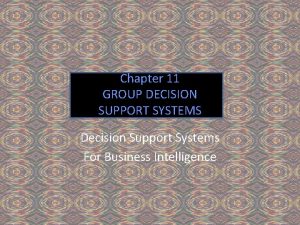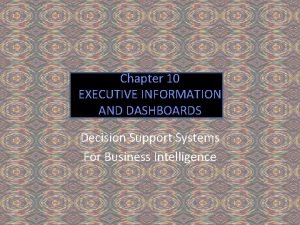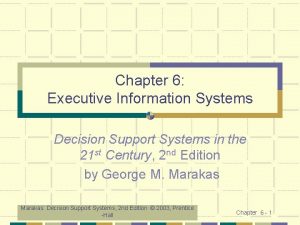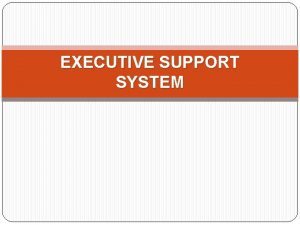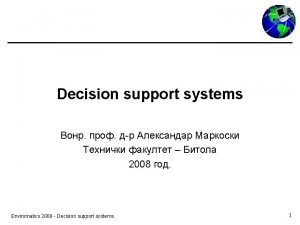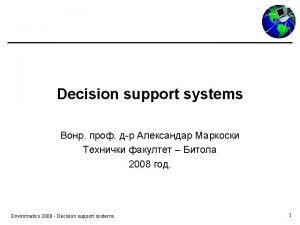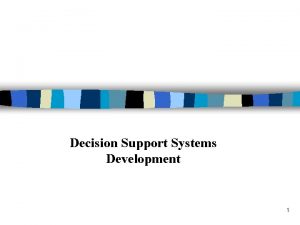Chapter 12 Decision Support Executive and Geographic Information






























- Slides: 30

Chapter 12 Decision Support, Executive, and Geographic Information Systems

Learning Objectives ü When you finish this chapter, you will w Understand the steps followed in decision making. w Recognize the difference between structured and unstructured decision making. w Know the typical software components that decision support systems comprise. w Be able to distinguish between the main types of decision support systems. 2

Decision Making in Business ü Organization’s success depends on quality of managers’ decisions ü When decisions involve large amounts of information and processing, computer-based systems can make the process effective and efficient. 3

The Decision-Making Process ü Three decision-making phases w Intelligence w Design w Choice 4

The Decision-Making Process Figure 12. 1 The three phases of decision making 5

Structured and Unstructured Problems Figure 12. 2 Business problems vary from structured to unstructured. Many fall between the two extremes and are considered semistructured. 6

Structured and Unstructured Problems ü Structured Problems w Proven set of steps for solution Algorithm ü Unstructured Problems w Multiple potential solution ü Semistructured Problems w Neither fully structured nor totally unstructured 7

Structured and Unstructured Problems ü Programmable Problems w Specific programs can be written to solve Structured problems are programmable Unstructured problems are unprogrammable ü Managers and Semistructured Problems w Most common type of problem for managers 8

Structured and Unstructured Problems Figure 12. 3 Examples of structured and semistructured problems 9

DSS Components ü Decision Support Systems (DSS) w Computer-based information systems that help managers select one of many solutions Automates some of decision-making process Sophisticated and fast analysis Used at all management levels 10

DSS Components w Three Major Components Data management module Model management module Dialog management module w Together, DSS modules: Help enter request conveniently Search vast amounts of data Use data in desired models Present results in readable manner 11

DSS Components Figure 12. 4 Components of a DSS and their interaction 12

DSS Components ü The Data Management Module w Gives user access to databases w Usually linked to external databases 13

DSS Components ü The Model Management Module w Selects appropriate model to analyze data Linear regression model 14

DSS Components Figure 12. 5 A linear regression model for predicting sales volume as a function of dollars spent on advertising 15

DSS Components ü The Dialog Module w Interface between user and other modules Prompts user to select a model Allows database access and data selection Lets user enter/change parameters w Displays analysis results Textual, tabular, and graphical displays 16

DSS Components Figure 12. 6 A DSS helps marketers make decisions. 17

Types of Decision Support Systems ü Personal Decision Support Systems w Serve individual users in daily decision making w Run on personal computers w Single model for data processing 18

Types of Decision Support Systems Figure 12. 7 An investment DSS shows an analysis of individual stocks (top), and risk levels by economic sector and country (bottom). 19

Types of Decision Support Systems ü Group Decision Support Systems w Promote brainstorming and group decision making w Located in conference room or on networked computers w Weigh votes to overcome impasses 20

Types of Decision Support Systems Figure 12. 8 A GDSS Room 21

Sensitivity Analysis ü Sensitivity analysis w Tests degree to which result is affected by change in parameters w What-if analysis w Can change multiple parameters at once 22

Executive Information Systems ü Executive Information Systems (EIS) w Alleviate information overload for executives w Select most relevant data for analysis Drilling down w Consolidate and summarize data w Display data graphically 23

Executive Information Systems ü An effective EIS has the following features: w An easy-to-use and easy-to-learn graphical user interface w On-request “drill-down” capability w On-demand financial and other ratios, and other indicators w Easy-to-use but sophisticated tools to allow navigation in databases and data warehouses 24

Executive Information Systems w Statistical analysis tools w The ability to respond to ad hoc queries and sensitivity analyses w Access to external data pools w The ability to solve diverse business problems 25

Developing Decision Support Systems ü When Should a DSS Be Built? w What is the type problem and how structured is it? w Are the required data available in databases and data warehouses? w How often do managers encounter the problem? w Who will use the system? w Can the prospective users spare adequate time for the development process? 26

The Electronic Spreadsheet: A DSS Tool ü Provide two facilities for building DSS w Preprogrammed functions w Ability to use IF-THEN statements ü Most widely used tool w Inexperienced users can use to develop DSSs 27

Geographic Information Systems ü Geographic Information System (GIS) w Decision aid for map-related decisions ü Typical GIS contains w Database of quantitative and qualitative data w Database of maps w Program to display information on maps 28

Ethical and Societal Issues Decisions by Machines ü Automated decisions can affect individuals. w Mortgage companies, credit card companies, employers, banks, etc. ü European Protection w “Automated Individual Decisions” Directive 29

Ethical and Societal Issues Decisions by Machines ü Who Needs Protection w Determining creditworthiness Efficient Effective ü Hidden Injustice w Mistakes on records w Decisions final 30
 No decision snap decision responsible decision
No decision snap decision responsible decision Financial decision
Financial decision Executive decision meaning
Executive decision meaning Five step decision making process
Five step decision making process Chapter 11 decision making and relevant information
Chapter 11 decision making and relevant information Chapter 11 decision making and relevant information
Chapter 11 decision making and relevant information Executive support system
Executive support system Purpose of enterprise decision support system
Purpose of enterprise decision support system Executive information system (eis)
Executive information system (eis) Executive support systems
Executive support systems Executive support systems
Executive support systems Executive support systems
Executive support systems Executive support systems
Executive support systems Executive support systems
Executive support systems Bis mis
Bis mis Decision table and decision tree examples
Decision table and decision tree examples Decision support systems and intelligent systems
Decision support systems and intelligent systems Group decision support and groupware technologies
Group decision support and groupware technologies Decision support and business intelligence systems
Decision support and business intelligence systems Disadvantages of gdss
Disadvantages of gdss Decision support and business intelligence systems
Decision support and business intelligence systems Ai dss
Ai dss Decision support system and expert system
Decision support system and expert system Decision support system vs expert system
Decision support system vs expert system Minor details
Minor details Pengertian executive information system
Pengertian executive information system Pengertian executive information system
Pengertian executive information system Components of executive information system
Components of executive information system An information system is a combination of
An information system is a combination of Types of information system
Types of information system Components of dss
Components of dss




